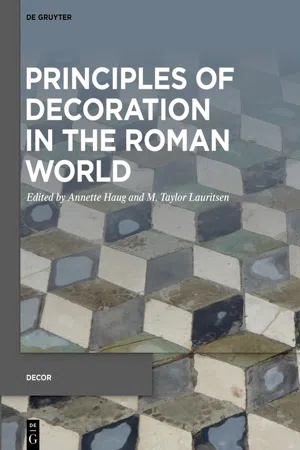
Principles of Decoration in the Roman World
Annette Haug, M. Taylor Lauritsen, Annette Haug, M. Taylor Lauritsen
- 201 páginas
- English
- ePUB (apto para móviles)
- Disponible en iOS y Android
Principles of Decoration in the Roman World
Annette Haug, M. Taylor Lauritsen, Annette Haug, M. Taylor Lauritsen
Información del libro
DECOR ist die erste Reihe, die sich mit Decor-Phänomenen im umfassenden Sinn beschäftigt. Dabei werden Decor-Formen nicht als isolierte Einzelelemente, sondern in ihrem räumlich-architektonischen und visuellen Wirkzusammenhang betrachtet. Dies bedeutet, dass nicht nur Bilder, sondern auch Ornamente in die Überlegungen einbezogen werden und somit ein Zusammenspiel von Decor-Elementen unterschiedlicher semantischer Dichte zu diskutieren ist. Decor-Elemente werden dabei dezidiert auf ihren Bezug zum Raum hin befragt, in dem sie zur Wirkung kommen. Es geht also um Analyse von Bild-Räumen bzw. Decor-Räumen. Dadurch rücken auch der Betrachter und seine Wahrnehmungshaltungen in den Vordergrund.
Der geographische Fokus liegt auf Italien, der chronologische Rahmen reicht vom 2. Jh. v. Chr. bis zum Ende der frühen Kaiserzeit im späten 1. Jh. n. Chr. In diese Zeit fallen nicht nur tiefgreifende politische und soziale Umwälzungen, sondern auch mehrmalige, tiefgreifende Veränderungen der Decor-Prinzipien. Gerade für diesen zeitlichen und räumlichen Kontext lässt sich besonders fruchtbar nach der Relation zwischen veränderten Handlungs- und Erlebnisformen einerseits und sich ändernden Decor-Strategien andererseits fragen.
Preguntas frecuentes
Información
Ornamental Painting on Campanian House Façades
Abstract
The Casa del Poeta Tragico
Índice
- Title Page
- Copyright
- Contents
- Introduction: Principles of Decor
- Decoration and Attention in the Forum of Augustus: The Agency of Ancient Imagery Between Ritual and Routine
- Decorative Features and Social Practices in Spaces for Agricultural Production in Roman Villas
- Decorative Principles Between the Public and Private Spheres in Pompeii: Contexts, Patrons and Artisans
- The Capitolium at Brescia in the Flavian Period
- Ceiling Decor Contextualised: A Case Study from the ‘Casa di Augusto’ on the Palatine
- From Insula to Dwelling: Architectural Transformations and Principles of Decor in Insula V at Herculaneum
- Ornamental Painting on Campanian House Façades
- The Murals of the Synagogue at Dura Europos as an Expression of Roman Koine
- All the World’s a Stage: On the Interplay of Decoration in Pompeian Houses
- The Intermediality of Landscape in the Decorum of Roman Villas